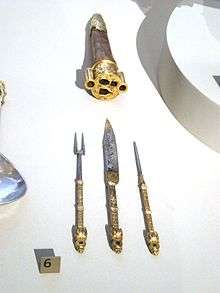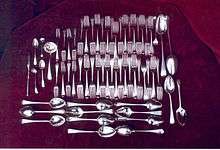Cutlery
Cutlery includes any hand implement used in preparing, serving, and especially eating food in Western culture. A person who makes or sells cutlery is called a cutler. The city of Sheffield in England has been famous for the production of cutlery since the 17th century and a train – the Master Cutler – running from Sheffield to London was named after the industry.[1] Bringing affordable cutlery to the masses, stainless steel was developed in Sheffield in the early 20th century.[2]

Cutlery is more usually known as silverware or flatware in the United States, where cutlery usually means knives and related cutting instruments.[3] Although the term silverware is used irrespective of the material composition of the utensils, the term tableware has come into use to avoid the implication that they are made of silver.
The major items of cutlery in Western culture are the knife, fork and spoon. These three implements first appeared together on tables in Britain in the Georgian era.[4] In recent times, hybrid versions of cutlery have been made combining the functionality of different eating implements, including the spork (spoon / fork), spife (spoon / knife), and knork (knife / fork) or the sporf which combines all three.
Etymology
The word cutler derives from the Middle English word 'cuteler' and this in turn derives from Old French 'coutelier' which comes from 'coutel'; meaning knife (modern French: couteau).[5] The word's early origins can be seen in the Latin word 'culter' (knife).
Composition

Metallic
Sterling silver is the traditional material from which good quality cutlery is made. Historically, silver had the advantage over other metals of being less chemically reactive. Chemical reactions between certain foods and the cutlery metal can lead to unpleasant tastes. Gold is even less reactive than silver, but the use of gold cutlery was confined to the exceptionally wealthy, such as monarchs.[6]
Steel was always used for more utilitarian knives, and pewter was used for some cheaper items, especially spoons. From the nineteenth century, electroplated nickel silver (EPNS) was used as a cheaper substitute for sterling silver.
In 1913, the British metallurgist Harry Brearley discovered stainless steel by chance, bringing affordable cutlery to the masses.[2] This metal has come to be the predominant one used in cutlery. An alternative is melchior, corrosion-resistant nickel and copper alloy, which can also sometimes contain manganese and nickel-iron.
Plastic
Plastic cutlery is made for disposable use, and is frequently used outdoors for camping, excursions, and barbecues for instance. Plastic cutlery is also commonly used at fast-food or take-away outlets and provided with airline meals in economy class. Plastic is also used for children's cutlery. It is often thicker and more durable than disposable plastic cutlery.
Wooden
Wooden disposable cutlery is available as a popular biodegradable alternative. Bamboo and maple wood are a few popular choice of wood.
Edible
Edible cutlery is made from dried grains.[7] These are made primarily with rice, millets or wheat. Since rice cultivation needs a lot of water, manufacturers market millet based products as more environment friendly. The batter is baked in moulds which hardens it. Some manufacturers offer an option of flavoured cutlery. Edible cutlery decomposes in about a week if disposed.
Industry

At Sheffield the trade of cutler became divided, with allied trades such as razormaker, awlbladesmith, shearsmith and forkmaker emerging and becoming distinct trades by the 18th century.
Before the mid 19th century when cheap mild steel became available due to new methods of steelmaking, knives (and other edged tools) were made by welding a strip of steel on to the piece of iron that was to be formed into a knife, or sandwiching a strip of steel between two pieces of iron. This was done because steel was then a much more expensive commodity than iron. Modern blades are sometimes laminated, but for a different reason. Since the hardest steel is brittle, a layer of hard steel may be laid between two layers of a milder, less brittle steel, for a blade that keeps a sharp edge well, and is less likely to break in service.
After fabrication, the knife had to be sharpened, originally on a grindstone, but from the late medieval period in a blade mill or (as they were known in the Sheffield region) a cutlers wheel.
Disposable cutlery
Plastic

Introduced for convenience purposes (lightweight, no cleanup after the meal required), disposable cutlery made of plastic has become a huge worldwide market.[8][9] Along with other disposable tableware (paper plates, plastic table covers, disposable cups, paper napkins, etc.), these products have become essential for the fast food and catering industry. The products are emblematic of throw-away societies and the cause of millions of tons of non-biodegradable plastic waste.[10] The European Union will be banning such plastic products from 2021 as part of the European Plastics Strategy.[11][12]
Wooden
As an ecofriendly alternative to non-degradable plastic, wooden cutlery is gaining popularity. Some manufacturers coat their products in food-safe plant oils, waxes and lemon juice for a longer shelf life making these safe for human consumption. Cutlery is then cured for a few days before leaving the manufacturing plant.[13]
Edible
Edible cutlery is gaining popularity as an eco-friendly alternative to non-decomposing plastic. Bakey's based in Hyderabad, India is a popular edible cutlery manufacturer established by a former scientist. At Bakey's millet based dough is poured into metallic moulds and baked at 280 °C (540 °F) for about 28 minutes which hardens it. [14]
Manufacturing centres
Traditional centres of cutlery-making include:
- Caldas das Taipas in Portugal
- Albacete in Spain
- Meriden and Oneida in United States of America
- Premana in Italy
- Sheffield in the United Kingdom
- Solingen in Germany
- Thiers and Laguiole in France
- Toledo in Spain
- Wazirabad in Pakistan
- Galway in Ireland
Edible cutlery manufacturing centers:
See also
- Cutler (disambiguation)
- Eating utensil etiquette
- Steak knife
- Table setting
- Tableware
- List of eating utensils
- List of food preparation utensils
- Sujeo
References
- British Pathé. "The Master Cutler". britishpathe.com.
- "Made in Great Britain, Series 1, Steel". BBC. Retrieved 28 March 2019.
- "Restodontê | Tipos de facas e suas utilidades". Restodontê. Retrieved 2019-07-04.
- Extraordinary Origins of Everyday Things. Reader's Digest. 27 November 2009. p. 49. ISBN 978-0276445699.
- The Sheffield Knife Book, Geoffrey Tweedale, The Hallamshire press, 1996, ISBN 1-874718-11-3
- Miodownik, Mark (29 April 2015). "Stainless steel revolutionised eating after centuries of a bad taste in the mouth". The Guardian.
- "Edible Cutlery Market to Witness an Outstanding Growth During 2018 to 2026". The Guardian Tribune. 23 August 2019.
- "Environmental Impact of Plastic Cutlery and Some Affordable Solutions". Conserve Energy Future. 2018-12-07. Retrieved 2019-06-03.
- "GUIDES: EATS". Plastic Pollution Coalition. Retrieved 2019-06-03.
- Schnurr, Riley E.J.; Alboiu, Vanessa; Chaudhary, Meenakshi; Corbett, Roan A.; Quanz, Meaghan E.; Sankar, Karthikeshwar; Srain, Harveer S.; Thavarajah, Venukasan; Xanthos, Dirk; Walker, Tony R. (2018). "Reducing marine pollution from single-use plastics (SUPs): A review". Marine Pollution Bulletin. 137: 157–171. doi:10.1016/j.marpolbul.2018.10.001. PMID 30503422.
- "EU Plastics Strategy". European Commission - European Commission. Retrieved 2019-06-03.
- Valdivia, Ana Garcia (2019-01-22). "The End Of Plastic Cutlery, Plates And Straws: EU Market Says Goodbye To Single-Use Plastic Products". Forbes. Retrieved 2019-06-03.
- "Wooden cutlery manufacturing". How it's Made.
- "Edible cutlery allows you to eat with them, then gobble them up". The Hindu newspaper. 13 July 2019.
- Borah, Prabalika M. (2018-07-13). "Bakey's edible cutlery allows you to eat with them, then gobble them up". The Hindu. ISSN 0971-751X. Retrieved 2019-09-02.
Further reading
- Hey, D. The Fiery Blades of Hallamshire: Sheffield and Its Neighbourhood, 1660–1740 (Leicester University Press 1991). 193–140.
- Lloyd, G. I. H. The Cutlery Trades: An Historical Essay in the Economics of Small Scale Production. (1913; repr. 1968).
External links
| Look up cutlery in Wiktionary, the free dictionary. |
| Wikimedia Commons has media related to Cutlery. |
- Associazione culturale Coltellinai Forgiatori Bergamaschi - Research laboratory on damascus steel